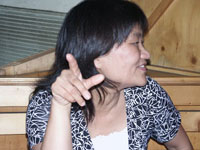|
Teaching
Cultural/Film Studies in South Korea
The presentation has two agendas:
[1] The construction of a synopsis of the emergence and continuing practice of cultural studies in South Korea, with special attention to how it is connected not only to the various intellectual scenes but also to the publishing industries and journalistic discourse.
[2] The tracing of the pedagogic trajectory into which and through which cultural studies is articulated and articulates itself within other disciplines – film studies in particular.
I will begin with the second agenda first, giving, by way of illustrative example, an overview of the curriculum development of the Cinema Studies Department at the Korean National University of the Arts
(KNUA), founded in the early 1990s, where I teach.
KNUA is the first art school in South Korea subsidized by the state. The reason the KNUA curriculum exceeds an individual case is that the school itself has been set up in the process of restructuring the local cultural policy and education during the post –dictatorship era, anticipating and confronting expedited globalization .
Initially conceived as conservatory, one of the aims of KNUA is to bring a change to local art education . Composed of seven schools of Music, Drama. Film and Multimedia, Arts, Dance and Traditional Music , one of the distinctive features is that each school has its own theory department . Hence, the Cinema Studies Department has established itself a constituent of
KNUA, which is in fact very rare for art schools. In the milieu of the alternative school where many students re-enter to be trained for their second BA and MA degrees, Cinema Studies has developed a curriculum attentive to critical theory, cultural studies and cinema studies while engaging critical interventions in the film industry . In a word, it aims to produce a group of emergent subjects knowledgeable in the problematics of cinema and cultural studies as well as in the issues of culture industry (screen culture industry). Therefore, deliberately avoiding the orthodox discipline of cinema studies elsewhere (if such an orthodoxy exists), the program envisions a specific screen culture studies which is by definition broader than film and TV studies . With the establishment of the graduate program, it takes a concrete form of more locally and linguistically specific cinema /cultural studies. The example is East Asian cinema studies.
The faculty in cinema studies (three tenured professors, one or two visiting professors and 25 part- time lecturers) is comprised of people who are also involved with NGOs such as cultural coalition groups, the cultural studies journal movement, feminist artist networks , alternative film festivals as well as alternative/counter film theory. |

